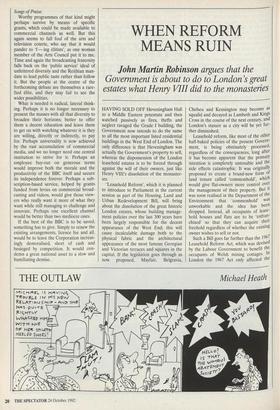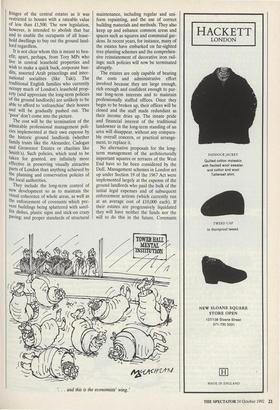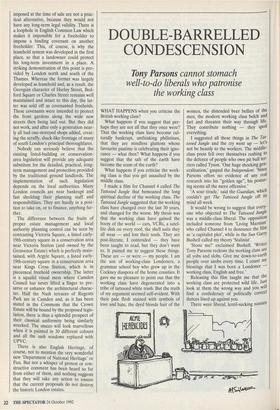WHEN REFORM MEANS RUIN
John Martin Robinson argues that the
Government is about to do to London's great
estates what Henry VIII did to the monasteries
HAVING SOLD OFF Heveningham Hall to a Middle Eastern potentate and then watched passively as fires, thefts and neglect ravaged the Grade I building, the Government now intends to do the same to all the most important listed residential buildings in the West End of London. The only difference is that Heveningham was actually the Government's property to sell, whereas the dispossession of the London leasehold estates is to be forced through against the will of their owners, just like Henry VIII's dissolution of the monaster- ies.
'Leasehold Reform', which it is planned to introduce to Parliament in the current session as part of the Housing, Land and Urban Redevelopment Bill, will bring about the dissolution of the great historic London estates, whose building manage- ment policies over the last 300 years have been largely responsible for the decent appearance of the West End; this will cause incalculable damage both to the physical fabric and the architectural appearance of the most famous Georgian and Victorian terraces and squares in the capital. If the legislation goes through as now proposed, Mayfair, Belgravia, Chelsea and Kensington may become as squalid and decayed as Lambeth and Kings Cross in the course of the next century, and London's stature as a city will be yet fur- ther diminished.
Leasehold reform, like most of the other half-baked policies of the present Govern- ment, is being obstinately processed, regardless of the consequences, long after it has become apparent that the primary intention is completely untenable and the side effects catastrophic. It was originallY proposed to create a brand-new form of land tenure called `commonhold', which would give flat-owners more control over the management of their property. But It was soon realised in the Department of the Environment that `commonhold' Was unworkable and the idea has been dropped. Instead, all occupants of lease- hold houses and flats are to be 'enfran- chised' so that they can acquire their freehold regardless of whether the existing owner wishes to sell or not.
Such a Bill goes far further than the 1967 Leasehold Reform Act, which was devised by the Labour Government to benefit the occupants of Welsh mining cottages. In London the 1967 Act only affected the fringes of the central estates as it was restricted to houses with a rateable value of less than £1,500. The new legislation, however, is intended to abolish that bar and to enable the occupants of all lease- hold dwellings to buy out the ground land- lord regardless.
It is not clear whom this is meant to ben- efit; apart, perhaps, from Tory MPs who live in central leasehold properties and wish to make a quick buck, corporate ban- dits, assorted Arab princelings and inter- national socialites (like Taki). The traditional English families who currently occupy much of London's leasehold prop- erty (and appreciate the long-term policies of the ground landlords) are unlikely to be able to afford to 'enfranchise' their houses and will be gradually pushed out. The 'poor' don't come into the picture. The cost will be the termination of the admirable professional management poli- cies implemented at their own expense by the historic ground landlords (whether family trusts like the Alexander, Cadogan and Grosvenor Estates or charities like Smith's). Such policies, which tend to be taken for granted, are infinitely more effective in preserving visually attractive parts of London than anything achieved by the planning and conservation policies of the local authorities.
They include the long-term control of new development so as to maintain the visual coherence of whole areas, as well as the enforcement of covenants which pre- vent buildings being splattered with satel- lite dishes, plastic signs and stick-on crazy Paving; and proper standards of structural maintenance, including regular and uni- form repainting, and the use of correct building materials and methods. They also keep up and enhance common areas and spaces such as squares and communal gar- dens. In recent years, for instance, many of the estates have embarked on far-sighted tree-planting schemes and the comprehen- sive reinstatement of decorative iron rail- ings; such policies will now be terminated abruptly.
The estates are only capable of bearing the costs and administrative effort involved because they are large enough, rich enough and confident enough to pur- sue long-term interests and to maintain professionally staffed offices. Once they begin to be broken up, their offices will be closed and the staff made redundant as their income dries up. The innate pride and financial interest of the traditional landowner in the long-term standing of an area will disappear, without any compara- ble overall concern, or practical arrange- ment, to replace it.
No alternative proposals for the long- term management of the architecturally important squares or terraces of the West End have so far been considered by the DoE. Management schemes in London set up under Section 19 of the 1967 Act were implemented largely at the expense of the ground landlords who paid the bulk of the initial legal expenses and of subsequent enforcement actions (which currently run at an average cost of £10,000 each). If their estates are progressively liquidated they will have neither the funds nor the will to do this in the future. Covenants imposed at the time of sale are not a prac- tical alternative, because they would not have any long-term legal validity. There is a loophole in English Common Law which makes it impossible for a freeholder to impose a binding covenant on another freeholder. This, of course, is why the leasehold system was developed in the first place, so that a landowner could protect his long-term investment in a place. A striking demonstration of this point is pro- vided by London north and south of the Thames. Whereas the former was largely developed as leasehold and, as a result, the Georgian character of Harley Street, Bed- ford Square or Charles Street remains well maintained and intact to this day, the lat- ter was sold off as covenanted freeholds. These covenants were intended to protect the front gardens along the wide new streets then being laid out. But they did not work, and after only a generation near- ly all had one-storeyed shops added, creat- ing the scruffy, shack-like frontage of many of south London's principal thoroughfares.
Nobody can seriously believe that the existing listed-building or conservation- area legislation will provide any adequate substitute for the detailed, practical, long- term management and protection provided by the traditional ground landlords. The implementation of such legislation depends on the local authorities. Many London councils are near bankrupt and fast shedding their planning staff and responsibilities. They are hardly in a posi- tion to take on, or to finance, anything fur- ther.
The difference between the fruits of proper estate management and local authority planning control can be seen by contrasting Victoria Square, a listed early- 19th-century square in a conservation area near Victoria Station (and owned by the Grosvenor Estate) which is perfectly main- tained, with Argyle Square, a listed early- 19th-century square in a conservation area near Kings Cross Station, which is in piecemeal freehold ownership. The latter is a squalid visual mess where Camden Council has never lifted a finger to pre- serve or enhance the architectural charac- ter. Half the Nash terraces of Regents Park are in Camden and, as it has been stated in the Commons that the Crown Estate will be bound by the proposed legis- lation, there is thus a splendid prospect of their classical uniformity being similarly wrecked. The stucco will look marvellous when it is painted in 30 different colours and all the sash windows replaced with UPVC.
There is also English Heritage, of course, not to mention the very wonderful new 'Department of National Heritage' or Fun. But not a whisper of protest or con- structive comment has been heard so far from either of them, and nothing suggests that they will take any action to ensure that the current proposals do not destroy the historic London estates.




































































 Previous page
Previous page